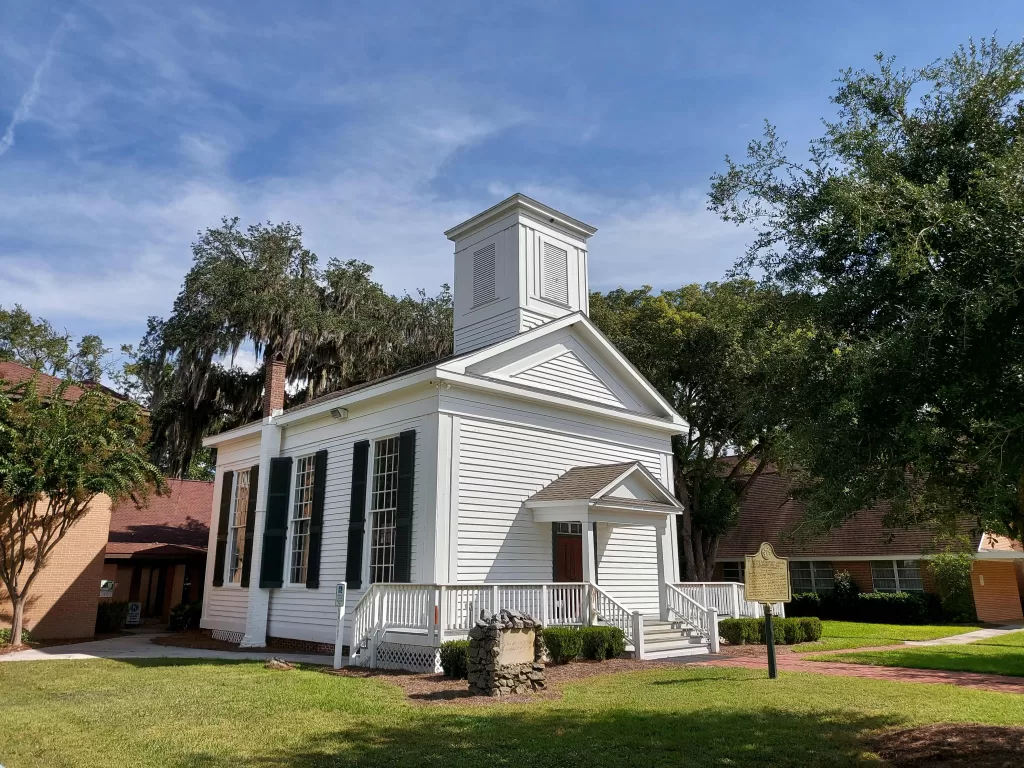St. Marys Spotlight: The United Methodist Church

“The country is very good for cattle, but a poor place for piety or morality.”
This was the observation of George Clark, the first Methodist preacher in St. Marys, on his arrival to this area in 1799.
It appears Clark – in fact the first Protestant minister to reach the St. Marys River – faced a Herculean task. However, in this holiday spotlight on the St. Marys Methodist Church, we will discover the enduring legacy and widespread influence the St. Marys Methodist Church has maintained throughout two centuries.
St. Marys: The First Wild West
When George Clark arrived in St. Marys as a circuit rider in 1799, he was surprised that when he held services, he needed to tell church-goers when to sit and stand, as many had never attended a church service before. At this time, there was no church south of the Altamaha River, 50 miles north of St. Marys.
St. Marys’ first permanent pastor, John Garvin, experienced difficulties, as well. His lodgings contained no doors and 40 pigs, and he had to preach in public buildings and under arbors since the Methodists had no church building. (The Union Church, or present First Presbyterian Church, was then non-denominational, but Methodists were barred from worshipping there.) In spite of these setbacks, Garvin grew the congregation to 14 members after a year’s work. Missionaries also used St. Marys as their home base for spreading Methodism into Florida in the early 1800s, making St. Marys’ church the mother church of Florida.
A Church is Born
In 1812, the city deeded land where the chapel now stands to the Methodist congregation, who immediately erected a plain wooden building with two entrances at the south end. The door on the right was for women and that on the left for men, as opposite sexes were not allowed to sit together. There was a gallery over the doors at the front of the building for the choir. At this point, music was entirely vocal; the Methodists opposed musical instruments for church purposes.
Not all parishioners had such “upright” leanings. The earliest records show church members’ being removed from rolls for neglecting to attend church, using profanity on the waterfront, general immorality, lying, intemperance, and adultery. Even by 1850, members were still being expelled for dancing, adultery, drunkenness, or neglect of religious duty. These records do show that in some instances, these members were later readmitted.
By 1839, the congregation had grown to 40 white and 43 African American members. Around 1856, the original chapel was given to the Black Methodists, although many believed the building was so rotten it should have been replaced. This old church was rolled to a lot on the Northeast corner of Dillingham and Osborne Streets for the African Americans’ use.
A Church in Turmoil
In 1858, the “new” chapel we know today was constructed in the Greek Revival Basilica style, but it soon closed its doors when Union soldiers occupying St. Marys during the Civil War used it to butcher their cattle and sheep. It appears the church’s being a “butcher shop” saved it from destruction; the Union spared buildings it used during its occupation, while others, such as the Episcopal Church on Wheeler Street, were not as lucky.

A major remodeling in 1913 endowed the chapel with its present look, with stained glass windows, a metal ceiling, and redone woodwork. Around this time in 1909, the then-pastor became ill, and a young man named Arthur J. Moore was sent to aid the church. He received his license to preach while in St. Marys and went on to become a bishop and one of the most outstanding preachers of Methodism.

The St. Marys Methodist Church, the oldest Methodist church in Camden County, has held services continually except during yellow fever epidemics and the Civil War. Today’s simple white chapel reflects the tenacity and dedication of St. Marys Methodists across the centuries. We are fortunate it remains as a picturesque reminder of the Methodists’ tenure here.
Get a closer look at this church on our Fugitives, Fighters, and Fudge: St. Marys Walking Tour! And don’t forget to check out our Cumberland Island Walking Tour!


